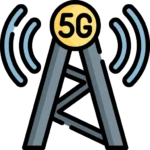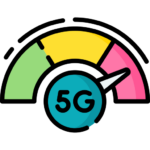5G Business Broadband
Superfast broadband without landlines, engineers or waiting periods.
Just enter your business postcode…
Superfast broadband without landlines, engineers or waiting periods.
Just enter your business postcode…
5G business broadband can be faster and more cost-effective for small businesses, but speeds depend on proximity to the nearest antenna.
In this guide, we’ll help you decide if 5G business broadband is right for your business. We cover:
5G business broadband is the fifth generation of technology for mobile business broadband. 5G was first rolled out in the UK in 2019 and now reaches 93% of UK premises.
Unlike most business broadband deals, 5G technology doesn’t use a physical cable to your business. Instead, it relies on electromagnetic waves transmitted from 5G antennas to transfer data.
5G business broadband uses a business broadband router with a 5G SIM card that simultaneously connects multiple devices and has business-specific features such as guest Wi-Fi.
Our business broadband experts summarise the top three benefits of 5G business broadband deals.

5G unlimited data business broadband prices are significantly cheaper than the equivalent fibre optic broadband deals.

In the right locations, 5G business broadband can provide faster speeds compared with standard fibre broadband.

No engineer or installation is needed. Receive your 5G router the day after your order to get your business online fast.
5G business broadband offers the best internet option for small businesses in the right locations. Here are the key considerations if you’re contemplating using a 5G business broadband connection.

Use signal checker to review which mobile companies offer 5G broadband at your business’s address. The 5G carriers EE, Vodafone, and Three all offer 5G business broadband services.

We recommend testing the 5G speed at your location before signing up for a 5G business broadband contract. The easiest way to do this is to run our speed test on a mobile that is connected to the 5G network of your chosen provider.

5G business broadband speeds are sufficient for simple activities like using card readers, VoIP calls, and emails. However, it may not be sufficient for more data-intensive activities.
5G technology has provided a significant speed boost to mobile technology, improving speed and bandwidth with:
In the UK, 5G offers average speeds of between 100 and 300 Mbps and up to 1,000 Mbps (just as fast as full fibre or cable business broadband).
The important thing to know about 5G business broadband speeds is that they vary significantly with distance from the 5G antenna, the number of nearby users, and can be affected by the weather.
💡 Review our full article comparing 5G vs fibre optic broadband performance.
There are now three major 5G business broadband providers competing to offer unlimited 5G business broadband deals.
Here, we’ll compare the 5G business broadband deals offered by each:

The EE 5G network is the widest-reaching in the UK, available in all major cities. EE offers a Smart 5G Hub for 5G business broadband. EE is part of the BT group of companies.

Three offers the cheapest unlimited data 5G business broadband hub. Three provides a 30-day money-back guarantee and next-day delivery for your business broadband router.

Vodafone business broadband offers a 5G business broadband router with an extensive 5G network. Vodafone is also in the process of rolling out a 5G Ultra network, which will offer faster speeds.